<snort-snort--stomp-stomp>
'Great! Where did you move, now?'
'Mescal is getting ready to ask your queen out on a date.'
Brett Rants
Talking Chess
or
Talking Smack.
It's pretty much the same thing.
Talking Smack.
It's pretty much the same thing.
This Is A Fun Position
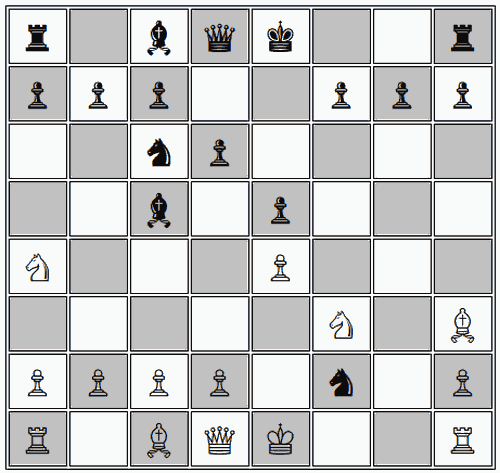
I'm Black.
It's White's Move.
White Doesn't Stand A Chance.
At one time, I suggested reading a chess book. The response was something along the lines of 'Ha, no way.'
So, here I am writing a post about chess, instead.
In fact, I was thinking about writing a whole series, but I've got too much on my hands, as it is. And I'm really not that good at chess. On the other hand, limited ability is often a better teacher than true genius... as it understands the failings of ignorance... its own ignorance.
So, here I am writing a post about chess, instead.
In fact, I was thinking about writing a whole series, but I've got too much on my hands, as it is. And I'm really not that good at chess. On the other hand, limited ability is often a better teacher than true genius... as it understands the failings of ignorance... its own ignorance.
An Easy Lesson
In Six Easy Pieces
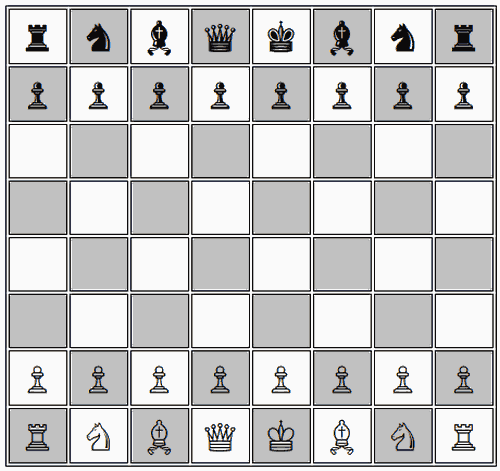
The Start!
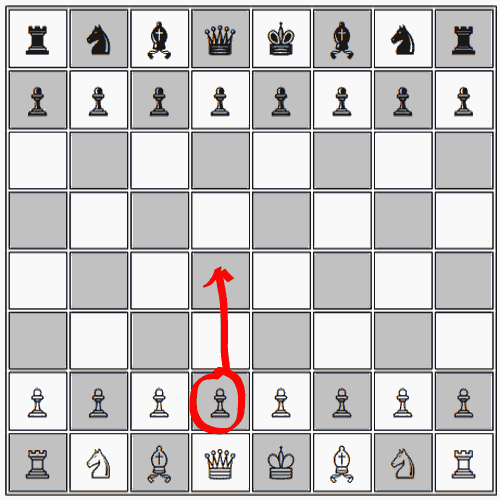
The First Move!
Do Not Think!
Do Not Pass Go!
Choose A First Move!
Stick With It!
This is my first move. And given the opportunity if playing Black, I will still move my Queen's Pawn Up Two. The only time (and this is the only time) I won't play Queen's Pawn Up Two as my first move is if my opposition plays King's Pawn Up Two, first.
Now, this might seem silly, as my opponent always knows my first move. But it has served me well. I play the same game over and over and over again. I know what I am doing and what I am going to do.
Do you?
If not, might I recommend advancing the Queen's Pawn as far as possible on your first move...
Do Not Pass Go!
Choose A First Move!
Stick With It!
This is my first move. And given the opportunity if playing Black, I will still move my Queen's Pawn Up Two. The only time (and this is the only time) I won't play Queen's Pawn Up Two as my first move is if my opposition plays King's Pawn Up Two, first.
Now, this might seem silly, as my opponent always knows my first move. But it has served me well. I play the same game over and over and over again. I know what I am doing and what I am going to do.
Do you?
If not, might I recommend advancing the Queen's Pawn as far as possible on your first move...
Winning's Not Everything
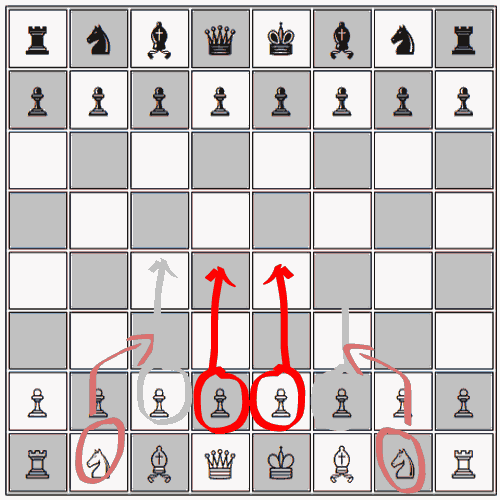
Fine!
Spice It Up!
Some folks can't leave well enough alone and insist on trying other openings. The red openings are solid, the pink less so, and the grey ones are questionable... at best.
Any other opening (yes, Virginia, any other opening) just means you do not care about winning.
It's fine.
Do what you want.
But if you want to win, you really need to stick with one of these openings... preferably, Queen's Pawn Up Two.
For those who want some sort of rationale besides my say so, think of Chess as a game of Real Estate. The center is the key. If you are not going for the center on your first move, you are yielding the center.
Um, thank you.
Thank you for the win.
Any other opening (yes, Virginia, any other opening) just means you do not care about winning.
It's fine.
Do what you want.
But if you want to win, you really need to stick with one of these openings... preferably, Queen's Pawn Up Two.
For those who want some sort of rationale besides my say so, think of Chess as a game of Real Estate. The center is the key. If you are not going for the center on your first move, you are yielding the center.
Um, thank you.
Thank you for the win.
Play Like A Pro
For The First Move, That IsI'm Not A Magician
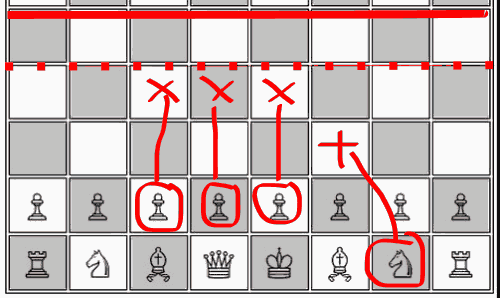
This Half Is Mine!
If you want to go on losing, then go on thinking the middle of the board resides at the fourth row mark.
No.
Not a chance.
I get five rows. You can have three... for now. Any further advance is an Act of War.
WAR! I tell you!
The four openings (as shown above) account for 98.83% of all Professional Opening Moves. This is it. They don't play anything else.
Though, having said that, there isn't much difference in the outcome, regardless of the opening move.
White Wins 34% of the time.
Black Wins 25% of the time, climbing to 30% if one of Big Four Opening Moves (as noted above) is not used.
With the 5% difference coming from ties, which happen 40% of the time (in cut throat play, when any one of the The Big Four Opening Moves are used) and fall to 35% if White gets creative and chooses something else as their first move.
And really, if anything I have said (or will say in the upcoming section) is news to you, you are simply not good enough to get creative and use something else as your first move.
No.
Not a chance.
I get five rows. You can have three... for now. Any further advance is an Act of War.
WAR! I tell you!
The four openings (as shown above) account for 98.83% of all Professional Opening Moves. This is it. They don't play anything else.
Though, having said that, there isn't much difference in the outcome, regardless of the opening move.
White Wins 34% of the time.
Black Wins 25% of the time, climbing to 30% if one of Big Four Opening Moves (as noted above) is not used.
With the 5% difference coming from ties, which happen 40% of the time (in cut throat play, when any one of the The Big Four Opening Moves are used) and fall to 35% if White gets creative and chooses something else as their first move.
And really, if anything I have said (or will say in the upcoming section) is news to you, you are simply not good enough to get creative and use something else as your first move.
Lesson Over
Eh, Not Quite
Here are some quick tips.
If in doubt, trade pieces. Beginning players get shaken up when they lose pieces. They come at the game with the conception that they only have so many pieces they can lose before the game is over. But a winner knows the opposite is true. The game is over after they capture so many pieces. So, clash. Destroy the opposition. Make them feel like they are loosing, even if (strictly speaking) that's not the case.
That said, only trade pieces if the points are even (like for like, bishop for knight, or knight for bishop) and don't give up position.
If in doubt, trade pieces. Beginning players get shaken up when they lose pieces. They come at the game with the conception that they only have so many pieces they can lose before the game is over. But a winner knows the opposite is true. The game is over after they capture so many pieces. So, clash. Destroy the opposition. Make them feel like they are loosing, even if (strictly speaking) that's not the case.
That said, only trade pieces if the points are even (like for like, bishop for knight, or knight for bishop) and don't give up position.
{In the above, I assume that a person is smart enough not to make a Bad Trade. Queens are better than Rooks. So, never trade a Queen for a Rook. But by all means, make the opposite trade whenever possible.}
Now, position is hard to understand. So, until better ideas come along, it may be helpful to simply assume a piece is in better position the further down the board it is and the more moves you've put into it.
On the other hand (and this will be the last tidbit I share), don't overextend yourself. Often the win comes from the opponent's mistakes. Meaning all one has to do to win is avoid being the first to make a mistake, which in many cases, simply means not overextending oneself. I mean, great, I said the first five rows were mine, but that's just bluster. They are mine when you cannot defend them any longer... and not a moment before.
On the other hand (and this will be the last tidbit I share), don't overextend yourself. Often the win comes from the opponent's mistakes. Meaning all one has to do to win is avoid being the first to make a mistake, which in many cases, simply means not overextending oneself. I mean, great, I said the first five rows were mine, but that's just bluster. They are mine when you cannot defend them any longer... and not a moment before.
next Brett Rants entry
Home Brett Rants Index
This is another one of those projects that has taken years from inception to completion... well, at least the one year, maybe two, probably not three.
© copyright 2019-2020 Brett Paufler
paufler.net@gmail.com
!!!BONUS!!!
HTML Chessboard
Look in the underlying HTML for a Chessboard Rendered as an HTML Table... you know, if such a thing interests you. The images for this page are merely reworked screen-captures of the following HTML Board, with the unicode symbols moved to the relevant positions in the table.
| ♜ | ♞ | ♝ | ♛ | ♚ | ♝ | ♞ | ♜ |
| ♟ | ♟ | ♟ | ♟ | ♟ | ♟ | ♟ | ♟ |
| ♙ | ♙ | ♙ | ♙ | ♙ | ♙ | ♙ | ♙ |
| ♖ | ♘ | ♗ | ♕ | ♔ | ♗ | ♘ | ♖ |